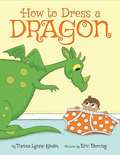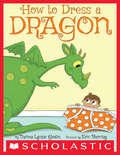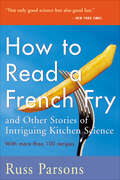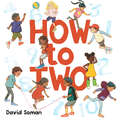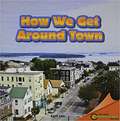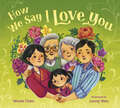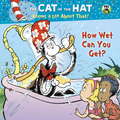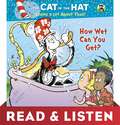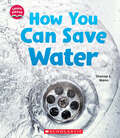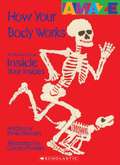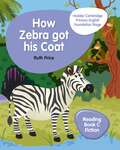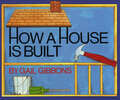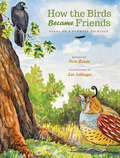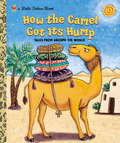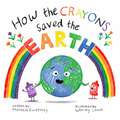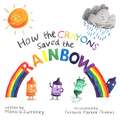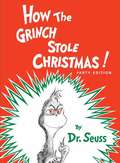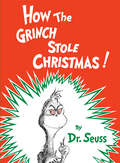- Table View
- List View
How Steven the Bear Invented S'mores (Steven the Bear)
by Scott HallHow Steven the Bear Invented S’mores is a read aloud picture book with fun life lessons and colorful illustrations. Steven the Bear and his friends are excited to go on their very first camping adventure. After being sure to pack and prepare well, the Bear Bunch heads out to find the perfect campsite. They set up camp and spend their day hiking, bird watching, and finding animals. After a day full of fun, Steven and the Bear Bunch sit down to toast marshmallows. That’s when Steven has a brilliant idea…? Join Steven the Bear and his friends in this first of many adventures!
How To Dress A Dragon
by Thelma Lynne GodinA small child helps his reluctant, toddler like dragon get dressed.
How To Dress a Dragon
by Thelma Lynne Godin Eric BarclayIf you have to dress a dragon, you must be prepared to catch him as he flies by. Also, beware of ticklish toes, shirts with buttons, and hats that do not fit neatly between his horns! In this charming, second-person narrative, our little boy hero imparts his infinite knowledge of how to dress a dragon, a task that isn't quite as easy as it may seem. With helpful hints like, You may have to tickle-tackle him to the floor and give him belly kisses, and warnings like, Dragons do not like shirts. But they do like capes! this story is not only delightfully entertaining, but extremely endearing. Author Thelma Lynne Godin and illustrator Eric Barclay come together perfectly to bring this fantasy to life!
How To Dress a Dragon
by Thelma Lynne GodinThis fantastical story about a little boy trying to dress his pet dragon is heartwarming, imaginative, and full of laughs! If you have to dress a dragon, you must be prepared to catch him as he flies by. Also, beware of ticklish toes, shirts with buttons, and hats that do not fit neatly between his horns! In this charming, second-person narrative, our little boy hero imparts his infinite knowledge of how to dress a dragon, a task that isn't quite as easy as it may seem. With helpful hints like, You may have to tickle-tackle him to the floor and give him belly kisses, and warnings like, Dragons do not like shirts. But they do like capes ! this story is not only delightfully entertaining, but extremely endearing. Author Thelma Lynne Godin and illustrator Eric Barclay come together perfectly to bring this fantasy to life!
How To Read A French Fry and Other Stories of Intriguing Kitchen Science: And Other Stories of Intriguing Kitchen Science
by Russ ParsonsWhy can you stick your hand into a 450-degree oven but not into 212-degree boiling water without burning it? Why does fish taste different from meat? Why do you cook pork differently from beef? Why should you always start cooking dried beans in cold water, not warm? Why should you never cook a Vidalia onion? What's the only kind of marinade that&’s really an effective tenderizer? Why is strawberry-rhubarb a good combination, scientifically speaking? And why don&’t potatoes fried in fresh oil ever brown completely, no matter how long they're cooked? &“Cooking is full of questions that science can help you answer, questions that can make you a better cook,&” writes the award-winning Los Angeles Times food editor, Russ Parsons. In this entertaining book packed with fascinating tidbits, Parsons explores the science behind such basic cooking methods as chopping, mixing, frying, roasting, boiling, and baking. You&’ll learn why soaking beans can&’t offset their gaseous effects, why green vegetables shouldn&’t be cooked under a lid for long, which fruits you can buy unripe and which you should buy fully ripened, which thickener to choose for your turkey gravy, and which piecrust is foolproof for a beginner. Along the way, Parsons slips in hundreds of cooking tips, provocative trivia, and touches of wit that make his scientific explanations go down smoothly. He also includes more than a hundred recipes that deliciously exemplify the principles he describes, from Tuscan Potato Chips and Crisp-Skinned Salmon on Creamy Leeks and Cabbage to Chocolate Pots de Creme and Ultimate Strawberry Shortcake.
How To Two
by David SomanFrom the co-creator of the New York Times bestselling Ladybug Girl series comes a joyful counting book about inclusivity, play, and the thrill of making new friends--from one to ten and back again.A quiet day at the playground turns into a boisterous park-wide adventure as one boy on the slide becomes two kids on the see-saw, then three jumping rope. Before long, ten new friends are playing like they've known one another forever.With its deceptively simple text and a rich visual narrative, How to Two is a playful counting and reverse-counting concept book as well as an exuberant celebration of inclusive play, friendship, and community."No two ways about it--this one is a delight." --Kirkus"A joyous celebration of play...Seamless...Diverse." --The Horn Book (starred review)"Inviting and welcoming." --BCCB (starred review)"Dynamic." --Booklist"Exciting." --Publishers Weekly
How Water Gets from Treatment Plants to Toilet Bowls (Here To There Ser.)
by Megan Cooley Petersonutilities; homes; community helpers; plumbers
How We Get Around Town (Infomax Common Core Readers)
by April LeeExplains the different ways people can get around town, including walking, biking, and driving.
How We Say I Love You
by Nicole ChenIn this heartwarming picture book, an Asian American girl shares how her family expresses their love for one another through actions rather than words.How do you tell your family that you love them? For Hana, love is all around her: Mom stirs love into a steaming pot of xifan. Dad cheers with love at her soccer game. Hana says good night with love by rubbing her grandma's feet and pouring her grandpa his sleepy tea. And as the light fades, Hana's parents tuck her into bed and give her a good night kiss. So many families express their love in all they do for one another, every day. Here is a book that wraps you in a hug and invites your family to share their own special ways of showing love.
How Wet Can You Get? (Pictureback(R))
by Joe Mathieu Aristides Ruiz Tish RabeSally and Nick are playing in the rain--and getting really muddy! So when the Cat in the Hat offers to show them how animals get clean, the kids are keen to find out. But can Sally and Nick really get rid of the mud by taking dust baths, like a sparrow? Or by licking themselves, like a lion? And where are they going to find an oxpecker to pick it off them, like a hippo has? (Besides, oxpeckers tickle!) Maybe there's a better way for a kid to get clean? Based on an episode of the new PBS Kids program The Cat in the Hat Knows a Lot About That!, this 16-page Pictureback comes with a sheet of adorable stickers featuring all the mud encrusted characters.
How Wet Can You Get? (Pictureback(R))
by Tish RabeRead and listen along with the Cat in the Hat! Sally and Nick are playing in the rain—and getting really muddy! So when the Cat in the Hat offers to show them how animals get clean, the kids are keen to find out. But can Sally and Nick really get rid of the mud by taking dust baths, like a sparrow? Or by licking themselves, like a lion? And where are they going to find an oxpecker to pick it off them, like a hippo has? (Besides, oxpeckers tickle!) Maybe there's a better way for a kid to get clean? Based on an episode of the hit PBS Kids tv show The Cat in the Hat Knows a Lot About That!This ebook includes Read & Listen audio narration.
How You Can Save Water (Learn About)
by Dionna L. MannAn essential tool to teach kids about the importance of water!Did you know that when water appears in your home, it must disappear from somewhere else? And that freshwater supply has to be shared by 7.7 billion people on Earth? If people do not conserve freshwater, there will not be enough for everyone. The good news is that there are lots of ways you can help save water. Learn all about them in How You Can Save Water.ABOUT THIS SERIES: Earth is known as the Blue Planet because of the abundant amount of water that covers our home. And nothing on Earth could survive without it. As we find ourselves facing a global water crisis, learning about this life-giving resource has never been more important. The books in this series are filled with colorful photos and diagrams, plus easy-to-digest text, and fascinating facts. And they offer young readers an in-depth look at what water is, how we use it, and most importantly, what we can do to protect it.
How Your Body Works: A Good Look Inside Your Insides
by David StewartWhat, Why, and How is explained with respect to human body.
How Zebra got his Coat
by Ruth PriceExplore, support and consolidate communication, language and literacy skills with a colourful story for ages 4-5, containing key concepts and practice opportunities. Practise key communication, language and literacy skills and concepts with simple question prompts on each page and activities at the end of the book. Support the themes covered in Activity Book C and the Teacher’s Pack. How Zebra got his Coat How did Zebra get his stripes? Find out in this African tale. Books in the Hodder Cambridge Primary English series for the Foundation Stage: Activity Book A – 9781510457249 Activity Book B – 9781510457256 Activity Book C – 9781510457263 Reading Book A FICTION No Nap for Grandad – 9781510457270 Reading Book B FICTION The Floating Market – 9781510457294 Reading Book C FICTION How Zebra got his Coat – 9781510457300 Reading Book A NON-FICTION Outside Play – 9781510457287 Reading Book B NON-FICTION Ring-a-Ting-Dingl – 9781510457331 Reading Book C NON-FICTION Let's Pretend – 9781510457348 Teacher’s Pack – 9781510457379 HODDER EDUCATION e: education@bookpoint.co.uk w: hoddereducation.com
How a City Works (Let's-Read-and-Find-Out Science 2)
by D. J. WardRead and find out about how cities work in this colorfully illustrated nonfiction picture book.Millions of people live in cities around the world, but have you ever wondered how cities work? All those people need clean water to drink, a safe place to live, and a way to get all around the city. How do you take care of all those people’s needs? Read and find out all about the systems a city has to help keep everyone safe, healthy, and happy.This book on city systems will appeal to the young civil engineer. How a City Works is filled with fun, accurate art, and includes tons of information. For example, it answers the question: Where does all the electricity needed to make a city run come from? How a City Works covers water treatment, power, sewage, recycling, and transportation.How a City Works comes packed with visual aids like charts, sidebars, an infographic, and a funny, hands-on activity—how to clean up dirty “sewage” water, using puffed rice cereal, raisins, hot chocolate mix, and coffee filters.This is a clear and appealing science book for early elementary age kids, both at home and in the classroom. It's a Level 2 Let's-Read-and-Find-Out, which means the book explores more challenging concepts for children in the primary grades. The 100+ titles in this leading nonfiction series are:hands-on and visualacclaimed and trustedgreat for classroomsTop 10 reasons to love LRFOs:Entertain and educate at the same timeHave appealing, child-centered topicsDevelopmentally appropriate for emerging readersFocused; answering questions instead of using survey approachEmploy engaging picture book quality illustrationsUse simple charts and graphics to improve visual literacy skillsFeature hands-on activities to engage young scientistsMeet national science education standardsWritten/illustrated by award-winning authors/illustrators & vetted by an expert in the fieldOver 130 titles in print, meeting a wide range of kids' scientific interestsBooks in this series support the Common Core Learning Standards, Next Generation Science Standards, and the Science, Technology, Engineering, and Math (STEM) standards. Let's-Read-and-Find-Out is the winner of the American Association for the Advancement of Science/Subaru Science Books & Films Prize for Outstanding Science Series.
How a House Is Built
by Gail GibbonsHouses are built with many different materials, and in many shapes and sizes. Step by step, this picture book explains how homes are built—from the architect's plans through the arrival of a happy family. The many processes of construction are explained with simple language and bright, clear illustrations, perfect for kids starting to wonder about how the world around them works. Many different careers—including carpenters, plumbers, electricians, and landscapers—are introduced, each doing their part to bring the picture wood-frame house to life. A great read for kids who love construction sites, or who can't get enough of Building a House by Byron Barton. According to The Washington Post, Gail Gibbons "has taught more preschoolers and early readers about the world than any other children's writer-illustrator." Ms. Gibbons is the author of more than 100 books for young readers, including the bestselling titles From Seed to Plant and Monarch Butterfly. Her many honors include the Washington Post/Childrens Book Fuild Nonfiction Award and the NSTA Outstanding Science Trade Book Award.
How a Seed Grows (Let's-Read-and-Find-Out Science 1)
by Helene J. JordanRead and find out about how a tiny acorn grows into an enormous oak tree in this colorfully illustrated nonfiction picture book.This is a clear and appealing environmental science book for early elementary age kids, both at home and in the classroom. Plus it includes a find out more activity section with a simple experiment encouraging kids to discover what a seed needs to grow.This is a Level 1 Let's-Read-and-Find-Out, which means the book explores introductory concepts perfect for children in the primary grades. The 100+ titles in this leading nonfiction series are:hands-on and visualacclaimed and trustedgreat for classroomsTop 10 reasons to love LRFOs:Entertain and educate at the same timeHave appealing, child-centered topicsDevelopmentally appropriate for emerging readersFocused; answering questions instead of using survey approachEmploy engaging picture book quality illustrationsUse simple charts and graphics to improve visual literacy skillsFeature hands-on activities to engage young scientistsMeet national science education standardsWritten/illustrated by award-winning authors/illustrators & vetted by an expert in the fieldOver 130 titles in print, meeting a wide range of kids' scientific interestsBook in this series support the Common Core Learning Standards, Next Generation Science Standards, and the Science, Technology, Engineering, and Math (STEM) standards. Let's-Read-and-Find-Out is the winner of the American Association for the Advancement of Science/Subaru Science Books & Films Prize for Outstanding Science Series.
How the Birds Became Friends
by Noa BaumA playful picture book with a powerful message from a national storyteller. With each bird desperate to prove himself superior to the others, can little Quail break the cycle with an act of kindness?
How the Camel Got Its Hump
by Katherine Scraper Lori O'Dea Juan Bautista Juan OliverNIMAC-sourced textbook
How the Camel Got Its Hump (Little Golden Book)
by Justine Fontes Ron Fontes Keiko MotoyamaWitty stories from around the world, and by the great writer Rudyard Kipling, "explain" how the camel got its hump. Fascinating facts about the camel round out this colorful book!
How the Crayons Saved the Earth (How the Crayons Saved #5)
by Monica SweeneyWhat can crayons do to save the planet?Something is happening to our big green and blue Earth! Pollution is making it hard for plants to grow, for animals to play, and for oceans to stay clean. But what can anyone do about it? On a yucky, smoggy day, a box of seven special crayons steps up to help! These peppy crayons are on another adventure to bring friendship, teamwork, and thoughtfulness to the world—but this time, it&’s the world that needs help. With their unique personalities, quirky attitudes, and stick-to-itiveness, this rainbow of friends puts their heads and hearts together to find a way to save the Earth. How the Crayons Saved the Earth is a colorful book about the environment from the plucky crayons who brought you the How the Crayons Saved the Rainbow series. How the Crayons Saved the Earth reminds kids about the importance of taking care of the Earth and that teamwork and determination can make a real difference.
How the Crayons Saved the Rainbow
by Monica Sweeney Feronia Parker-ThomasThe Sun and the Clouds are best friends. Together they keep the world warm, the gardens growing, and the sky full of beautiful rainbows. But one day they get into a fight and refuse to be in the sky together. And that means there are no longer any rainbows. Without rainbows, the colors start disappearing until Earth was left with no color ... except for one little forgotten box of crayons in one little school desk. <p><p> Determined to save the rainbows and fix the Sun and Clouds’ friendship, the crayons draw rainbows all over town. Their attempts go unnoticed. Soon they realize that they’re going to have to do something big to get the attention of the former friends. So, the crayons create the biggest rainbow they can and hope it’s enough to bring color back to the world.How the Crayons Saved the Rainbow teaches the importance of teamwork and perseverance through seven crayons with unique personalities and their desire to see the world in color.
How the Grinch Stole Christmas
by Dr Seuss"Every Who down in Who-ville liked Christmas a lot... but the Grinch, who lived just north of Who-ville, did NOT!" Not since "'Twas the night before Christmas" has the beginning of a Christmas tale been so instantly recognizable. No holiday season is complete without the Grinch, Max, Cindy-Lou, and all the residents of Who-ville, in this heartwarming story about the effects of the Christmas spirit on even the smallest and coldest of hearts. Like mistletoe, candy canes, and caroling, the Grinch is a mainstay of the holidays, and his story is the perfect gift for young and old. Images and image descriptions available.
How the Grinch Stole Christmas (Classic Seuss)
by Dr. SeussGrow your heart three sizes and get in on all of the Grinch-mas cheer with this Christmas classic--the ultimate Dr. Seuss holiday book that no collection is complete without! Every Who down in Who-ville liked Christmas a lot . . . but the Grinch, who lived just north of Who-ville, did NOT! Not since "'Twas the night before Christmas" has the beginning of a Christmas tale been so instantly recognizable. This heartwarming story about the effects of the Christmas spirit will grow even the coldest and smallest of hearts. Like mistletoe, candy canes, and caroling, the Grinch is a mainstay of the holidays, and his story is the perfect gift for readers young and old. "Irrepressible and irresistible." --Kirkus Reviews

